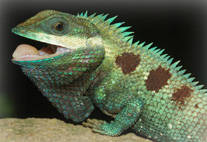Abstract
We describe a new species of the agamid genus Calotes Cuvier, 1817 from southern Vietnam, which is most similar to Calotes mystaceus Duméril & Bibron, 1837, but can be distinguished from the latter and its other congeners by genetic and morphological differences. We discuss the current distribution of the new species and its sister species C. mystaceus in Mainland Southeast Asia.
References
Arnedo, M.A., Hormiga, G. & Scharff, N. (2009) Higher-level phylogenetics of linyphiid spiders (Araneae, Linyphiidae) based on morphological and molecular evidence. Cladistics, 25, 1–32. http://dx.doi.org/10.1111/j.1096-0031.2009.00249.x
Hormiga, G. (1994a) Cladistics and the comparative morphology of linyphiid spiders and their relatives (Araneae, Araneoidea, Linyphiidae). Zoological Journal of the Linnean Society, 111, 1–71. http://dx.doi.org/10.1111/j.1096-3642.1994.tb01491.x
Hormiga, G. (1994b) A revision and cladistic analysis of the spider family Pimoidae (Araneoidea: Araneae). Smithsonian Contributions to Zoology, 549, 1–104. http://dx.doi.org/10.5479/si.00810282.549
Hormiga, G. (2000) Higher level phylogenetics of erigonine spiders (Araneae, Linyphiidae, Erigoninae). Smithsonian Contributions to Zoology, 609, 1–160. http://dx.doi.org/10.5479/si.00810282.609
Miller, J.A. & Hormiga, G. (2004) Clade stability and the addition of data: A case study from erigonine spiders (Araneae: Linyphiidae, Erigoninae). Cladistics, 20, 385–442. http://dx.doi.org/10.1111/j.1096-0031.2004.00033.x
Millidge, A.F. (1980) The erigonine spiders of North America Part 1. Introduction and taxonomic background (Araneae: Linyphiidae). The Journal of Arachnology, 8, 97–107.
Millidge, A.F. (1991) Further linyphiid spiders (Araneae) from South America. Bulletin of the American Museum of Natural History, 205, 1–199.

